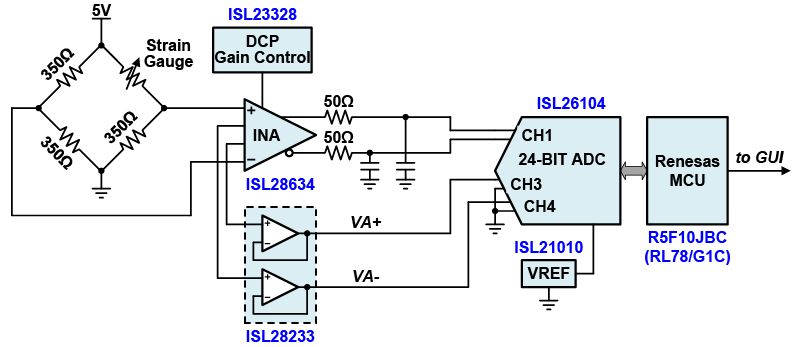Features
- Ultra-high precision front-end amplifier
- Zero-drift instrumentation amplifier
- Pin selectable 9 gain settings: G = 1 to 1,000
- Rail-to-rail input/output
- Differential output
- RFI filtered inputs improve EMI rejection
- Single supply: 2.5V to 5.5V
- Dual supply: ±1.25V to ±2.75V
- Low input offset: 5μV, Maximum
- Low input offset drift: 50nV/°C, Maximum
- High CMRR: 138dB, G = 100
- Low gain error: <0.4%, All Gains, Maximum
- Gain bandwidth: 2.3MHz
- Input voltage noise (0.1Hz to 10Hz): 0.4μVP-P
- Operating temperature range: -40 °C to +125 °C
Description
The ISL28635 is a 5V zero-drift rail-to-rail input/output (RRIO) Programmable Gain Instrumentation Amplifiers (PGIA). This instrumentation amplifier features low offset, low noise, low gain error, and high CMRR. It is ideal for high precision applications over the wide industrial temperature range. This in-amp is designed with a unique 2-bit, 3-state logic interface that allows up to 9 selectable gain settings. The ISL2863x differential output amplifier includes a reference pin to set the common-mode output voltage to interface with differential input ADCs.
Parameters
| Attributes | Value |
|---|---|
| Channels (#) | 1 |
| Bandwidth (MHz) | 2.3 |
| Gain Min | 1 |
| IBIAS (nA) | 0.05 |
| IOUT (A) | 0.04 |
| CMRR (dB) | 138 |
| PSRR (db) | 140 |
| Rail-to-Rail Input | Yes |
| Rail-to-Rail Output | Yes |
| IS per Amp (mA) | 2.9 |
| Noise VN (nV/√Hz) | 400 |
| Single Supply Voltage Range (V) | 2.5 - 5.5 |
| Slew Rate (V/µs) | 0.8 |
| VOUT (V) | 5.49 |
| VS (Min) (V) | 2.5 |
| VS (Max) (V) | 5.5 |
| AVOL (dB) | 140 |
| Topology [Rail 1] | VFA |
| Enable | No |
| Gain Error / Measurement Error (Max) | 0.05 |
| Qualification Level | Standard |
Package Options
| Pkg. Type | Pkg. Dimensions (mm) | Lead Count (#) | Pitch (mm) |
|---|---|---|---|
| TSSOP | 5.0 x 4.4 x 0.00 | 14 | 0.7 |
Applications
- Pressure and strain gauge transducers
- Weight scales
- Flow sensors
- Biometric: ECG/blood glucose
- Temperature sensors
- Test and measurement
- Data acquisition systems
- Low ohmic current sense
Applied Filters:
Filters
Software & Tools
Sample Code
Simulation Models
This video examines the use of instrumentation amplifiers (INA or in amps) for sensor applications. Intersil discusses the basics of the three-op amp INA, advantages of the zero-drift amplifiers, why use an RF input filter, monitoring sensor health, the advantages of programmable gain amplifiers and concludes with application examples for a sensor health monitor and an active shield guard drive.
The ISL2853x/63xEV2Z board allows simple evaluation of the ISL2853x and ISL2863x 5V zero drift programmable gain instrumentation amplifiers. Learn how easily you can set gain of amplifier anywhere from 1 to 1000.

